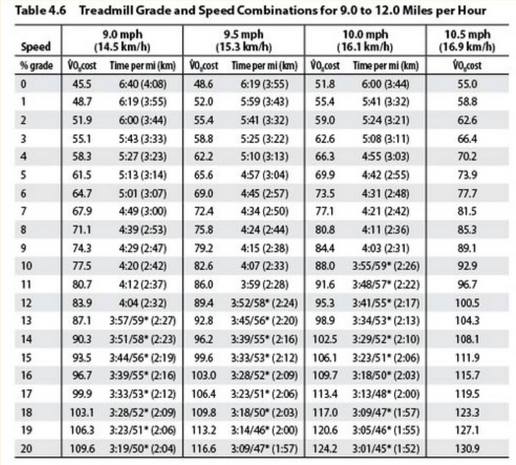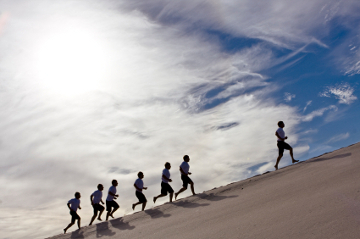If you’re a runner you’ve probably been exposed to the belief system of mind over matter, or mind over body, which is a simple way of saying that you can go beyond the physical limitations of your body and push yourself to do better if you simply believe that you can.
When we talk about running, the biggest challenge we face in a race is really a mental battle. Should I keep going, should I slow down, should I go faster, should I give up? The question is posed in our heads over and over as we push ourselves to our limits.
When we reach our limits physically we can make our body keep giving us just a little bit more.
But even mind over body has its limits and no matter how great our mind is, there aren’t a lot of people that can set world records in running without training. At some point in the race if you keep pushing yourself beyond your physical limitations your body is going to give out and slow down, even if you don’t want it to.
You will find that a little more planning and running intelligence can get you further than ignorance and mind over body. However, if you combine running intelligence WITH mind over body you will get your body to do great things for you.
The Failure of Running For Time and Pace
When I was in high school cross country the big thing our coach taught us was to “attack those hills” which is some of the worst advice I’ve ever received for running.
I don’t know if he told us that to get us mad at the hills we could get into the mind over body principle, but I what I do know is it wasted a lot of energy and hurt my overall time and place in the race.
Consider the following energy consumption chart below for hill grades.

The far left column represents the % of grade, the speeds you are running are at the top in both mph and km/h and in the cells below those speeds are the equivalent energy consumption times of both a mile and km at that speed and grade.
For example, if you run a 6 minute mile on a flat surface you are running at 10 miles per hour average for the entire 6 minutes. Since there is no grade you consume the energy of a 6 minute mile, however, if the average grade of that mile is done at 2% you will consume the energy equivalent of a 5:24 mile on a flat surface.
And herein lies the problem of running for pace and running for time.
Let’s pretend our target pace per mile of a 5k is 6 minutes or in other words when we come across the 3 mile mark just before we finish that last .1 miles we’d like our time to be at 18 minutes or less.
Let’s pretend we are running and the first mile is flat so we come across at 6 minutes, no problem. As we’re running the second mile it starts to get hilly, but we don’t want to fall behind our target pace of 6 minutes a mile so we pick it up a little bit, at mile 2 we come across at 12 minutes, we’re doing good right?
The third mile flattens out but we come across mile 3 with a total time of 19 minutes, meaning we ran a 7 minute last mile on a flat surface.
How could this happen you may wonder?
Obviously you need more endurance training because you couldn’t make the third mile with a 6 minute pace right?
WRONG

While endurance training may help, you may come to find out that the average grade of that second mile was 4% and by running at a speed of 10mph you actually consumed the equivalent energy of a 4 minute and 55 second mile during your second mile — oops!
This would probably cause your body to go passed its lactic threshold, leaving you stuck in a recovery stage for your third mile with exhaustion starting to take over.
Most of us running a 5k wouldn’t have been able to keep a 10 mph pace on a 4% grade, but if you are running for time or pace, you can quickly burn yourself out by not paying attention to what is really happening to your body when you go up a hill.
How to Run Up a Hill During a Race
If you want to do hill sprints or run up hills hard while you’re doing training intervals, have at it. But if you’re looking to perform well in a race, it’s not the best idea to race like you train on the hills.
The key to running up a hill is to maintain the same energy output while you’re going up the hill. This means that you will probably slow down enough that you won’t really notice that you’re running up a hill in terms of exhaustion or breathing.
You should also shorten your stride and take quicker steps instead of taking longer steps or making long strides. A good way to to put this concept into perspective is to use weight lifting as an example.
If you’re able to do 10 reps of 100lbs while bench pressing as your max workout, going up a hill with long strides is equivalent to trying to do 10 reps of 125lbs instead, which requires a lot more energy and for some may be impossible, you may find that after rep 5 you can’t do it anymore.
In this example, shortening your strides would be equivalent to doing 15 reps of 75 lbs, you’ll find that even though you do more reps, the weight load is relatively easy for you, meaning you probably won’t even be tired after those 15 reps and you didn’t expend as much energy.
This is exactly what happens when you run up a hill. The longer the stride, the heavier the load, and the more energy consumed.

If you’re having a hard time understanding this concept you can use a heart rate monitor. The way you can make sure you’re not using too much energy up on a hill is to maintain your race heart rate on flat land while going up a hill.
If your goal is a 6 minute mile and your heart rate on flat surface is 160 beats per minute, then you don’t want to try to run up a hill at 180 beats per minute. Maintaining the 160 beats per minute will require you to slow down slightly on the hill so that you’re not having to put more effort into going up the hill then you should be.
And on the opposite side of the equation, if you are going down hill you will naturally run faster with less energy.
The trick to running down a hill is to not slow yourself down too much You may run a 6 minute mile on flat land, a 630 mile on a 2% grade uphill, and a 530 on a 2% grade downhill to get your average pace of 6 minutes per mile, but if you’re not smart about hill running you can quickly deplete all of your energy right away and blow the race.
So just remember, running for time can be a very bad blind goal. Know the course, know your body, and know the target energy level you can sustain for the entire race.
I would love to see the rest of the chart. it says from 9mph to 12mph. I want to compare the difference. did you make this chart?
I would love to see the rest of the chart. it says from 9mph to 12mph. I want to compare the difference. did you make this chart?